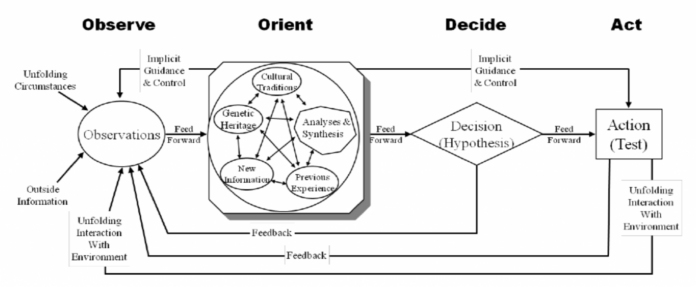Article Excerpt:
In this article Matt Devost and Bob Gourley provide practitioner’s context on a concept near and dear to our heart, the OODA Loop. In doing so we capture why this concept is so relevant to any competitive situation, including business and cybersecurity.
The OODA Loop is an approach to decision-making developed by retired Air Force Colonel John Boyd based on his decades of experience as a pilot and extensive study of the greatest battles in history.
OODA Stands for Observe, Orient, Decide and Act. It is called a loop to underscore the continuous nature of decision-making in dynamic, competitive environments.
Analysis:
The OODA Loop is a defined process whose objective is to obtain victory in competitive environments. Despite John Boyd’s intricate diagram of this loop, the process itself seems entirely human nature. Our bodies have been programmed to compete in order to survive, and this competitive nature seems to be embedded in our genetic code. Every day, we likely make decisions and take actions that would follow this framework, knowingly or unknowingly. It seems rather redundant to have to detail a process for how to think, but I think that this framework goes one step further in taking into consideration why we think the way we do. The “Orient” phase of this cycle is indicative of who is making the decision, and all of the factors that go into why an individual thinks that way. External influences such as “previous experience, cultural traditions, genetic heritage, and more are factors that the OODA cycle outlines to be influential on the “Decide” phase and, therefore, the “act” phase. If we are able to empathize with others, we may be able to understand how and why they make the decisions they do, and what external factors may affect these decisions.
In regards to military conflict or war, it is advantageous for the US to understand the adversaries respective OODA loops in order to anticipate how they will respond to certain events and advances that our militia may take. We must “get inside their heads” in order to remain one step ahead.




